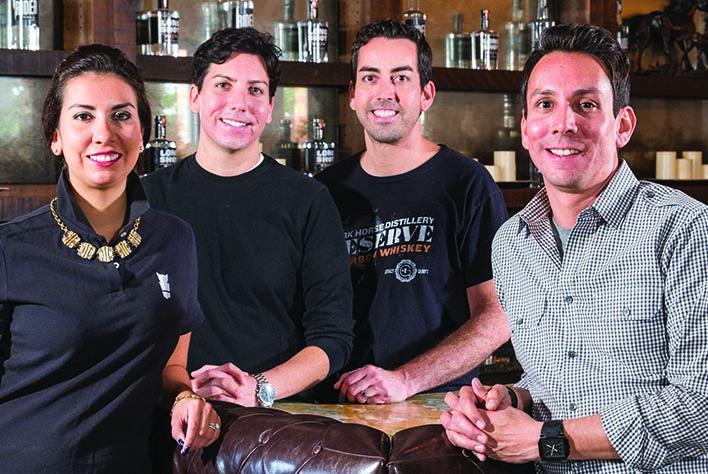Only a few years ago, Damian, Patrick and Eric Garcia were plugging away at their respective jobs in food and beverage sales, investment banking and law. Their little sister, Mary Garcia, was completing her college degree in English with no definite post-graduation plans.
The four siblings’ disparate interests and career paths suggested no compelling reason why they should start a small business together, except for one thing: They wanted to.
Their parents had raised them to believe in themselves and in one another, and that they could accomplish anything with enough effort. So, like a cocktail whose ingredients are combined in a new yet familiar way, the close-knit brood blended their diverse abilities into a family business built on trust, while giving their hometown of Kansas City something special to savor.
The result was the creation of the 20,000-square-foot Dark Horse Distillery, which offers a variety of spirits in small, handcrafted batches and where visitors take public tours and attend private functions in a dedicated event space.
Sales at Dark Horse Distillery have grown every year since bottling began in 2011 of its non-aged Rider Vodka and Long Shot White Whiskey, followed in 2012 by its aged Reserve Bourbon Whiskey and Reunion Rye Whiskey. All are currently available at approximately 325 bars, restaurants and shops in Kansas and Missouri.
So far, so great—but why a distillery and not, say, a dry cleaners, like the one where three of the four Garcias worked part time as teenagers? (For the record, the Garcias say, there was no TV-watching or other time-wasting allowed after school, thanks to the unwavering work ethic instilled by their role-model father, now a 38 year veteran at IBM.)
“We had talked a long time about applying all of our strengths and starting a family business, coming up with ideas, seeing what we could do,” said Damian, who heads Dark Horse sales. “And we’ve always had a love for whiskey and spirits in general.”
And Kansas City was lacking a craft distillery, said Mary, who runs the Dark Horse event space.
“Everyone in Kansas City is such a huge fan of Boulevard (Brewing Company), not only drinking the beer, but wearing the shirts and taking the tours,” she said. “So we decided to do something like Boulevard, but on the spirits side. And, hopefully, everyone in Kansas City could get behind us.”
But the Garcias were admittedly green when it came to producing quality spirits from scratch. Where would the recipes come from? How could they learn?
GRAIN TO GLASS
They began by visiting other microbreweries and distilleries to get a feel for how it was done, along with educating themselves about the many liquor retailers and brands in the market. “You have to make sure that this is really the right fit for you, before you start investing in equipment,” Damian said.
The fit felt good, but the avalanche of technical advice relating to the distillery business became dizzying without someone with the proper background to navigate the information.
“We started getting people telling us, ‘You need a (microdistillery) consultant,’” said Patrick, Dark Horse’s master distiller. “So we reached out to one consultant, who actually ended up becoming our consultant, and he kept me on the phone for about an hour. All I did was say, ‘Uhhuh, uh-huh, uh-huh,’ and just took notes the whole time.”
Of course, a distillery needs a physical location, and a spacious one was provided by the Garcias’ main investor in the form of an empty warehouse in Lenexa.
“And, once we got the still installed and all the piping hooked up, we were ready to roll,” Patrick said. “But, to tell you the truth, you have to do it to really learn it.”
What did the spirit-maker learn? “How to be a plumber,” he said. “There’s a lot of mechanical, a lot of plumbing, a lot of stuff back here (in the still house) that you never would’ve guessed that you’d have to know.”
When it comes to creating the spirits themselves—from milling the grain to pouring the finished product in a glass—there is also the necessity of appreciating subtle complexity.
“Our spirits have a lot more variety in flavor than you get in other larger bourbons out there,” Patrick said. “In our process, we don’t strip a lot of that flavor out. At some other distilleries, they chill-filter their whiskey. We don’t use those techniques and shortcuts.
“We take pride in what we do here. I check the still every 10 to 15 minutes when the spirit is coming off. You stick your finger in there. You can taste it on your tongue, smell it and rub it on your hands. There’s nothing automated about that whole process. We do everything by hand.”
MAKING IT AN EVENT
Plenty of federal and state licensing was required to get Dark Horse Distillery up and running— about a year and a half’s worth.
“What’s interesting is that the federal scheme for a distillery is not based on, ‘Is the product safe?’” said Eric, who serves as general manager. “The scheme is based on, ‘Are you going to pay your taxes?’ That’s the concern. It’s all about the money.”
On the state level, the Garcias also had to overcome a longstanding Kansas law prohibiting distilleries from serving the liquor that they produced, which would have been a deal-breaker for their business.
“We wanted to do things like tours with samples at the end and tasting events,” Eric said. “Kansas was still a very dry state. So we hired a lobbyist and talked to the committees in Topeka, and we got the law changed.”
The process was easier than expected because Kansas was already considering changes to its liquor laws in 2012, he said. State leaders wanted to increase tourism and foster companies like Dark Horse.
The change in Kansas law enabled the Garcias’ customer outreach through their event space, which is booked about threequarters of the year with wedding receptions, corporate retreats and other gatherings. The space’s richly decorated 6,500 square feet supply an additional revenue stream for the young business, while enhancing the relationship between the distilling process and the Dark Horse brand.
“When you have people walking through your door, they immediately start to care because it’s tangible,” Mary said. “It’s not like you’re just seeing that bottle onthe shelf. You care because you’re actually seeing that product being made and the hands that make that product. We want to be ingrained in your mind.”
ROLL OUT THE BARRELS
There is no secret to making whiskey, Eric said.
“Obviously, our recipe is different, and we take a lot of care in what we’re doing, and we feel ours is special,” he said. “But the techniques we’re using have been around for ages. So how do you set it apart? You set it apart by the things that you do.”
And the way that you grow—and growth is organic at Dark Horse Distillery, whose name was inspired by the Garcias’ self-perceived back-of-the-pack status starting out against familiar liquor brands.
“A lot of people who haven’t started a business before may think, ‘Well, growth is great— any growth is great,’” Eric said. “In some respects, perhaps, but at the same time it can also kill you. We always have an eye towards growth, but everything we do is very deliberate.”
Part of the unhurried strategy that’s proven popular with Dark Horse customers is the exclusive release of once-a-year spirits, including this November’s issue of Barrel Strength Reunion Rye Whiskey. The term “barrel strength” denotes a higher alcohol content of more than 100 proof.
“It’s coming straight from the barrel,” Patrick said, “as opposed to reverse-proofing it down with distilled water.”
Another successful trend is the distillery’s sales of charred five-liter and 10-liter empty minibarrels to bars and restaurants. Mixologists use them to make their own large cocktails, which can “age” for four to six weeks.
“We also have some places that are actually buying our used 10-gallon and 30-gallon whiskey barrels,” Damian said. “People are dumping their cocktails in and making it a whole year-round thing.” The Garcias simply want to keep introducing people to their work.
“Our product is unique and people need to taste it,” Eric said. “You can’t just hold it in front of their faces and say, ‘Isn’t this shiny? Don’t you want to try this?’ It’s important for us to get it in people’s mouths, so they can tell the difference between our product and maybe somebody else’s product.”


